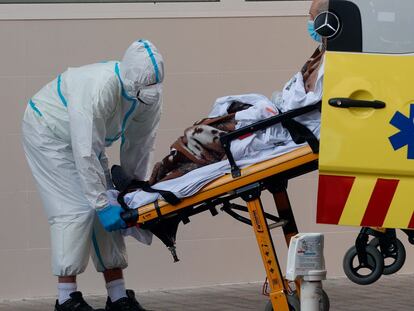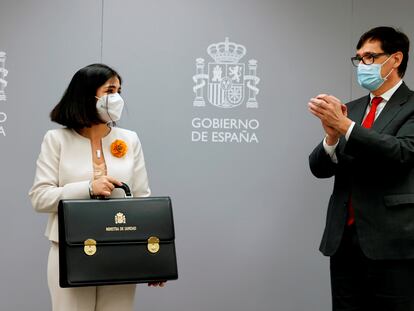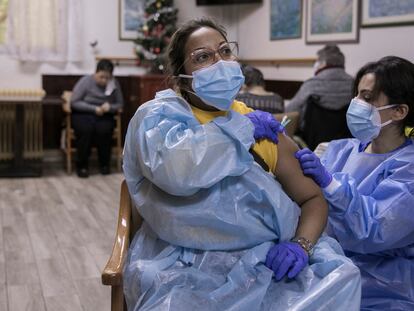Spain’s coronavirus incidence rate falls for the first time this year, but pressure on ICUs rises
The Health Ministry reported 34,899 new cases on Thursday and added 515 deaths to the official toll

The third wave of the coronavirus has pushed Spain to the breaking point. According to the Spanish Health Ministry’s latest report, released on Thursday, the country has started to flatten the curve of new infections, but it has done so at crisis levels, with pressure on hospitals, especially in intensive care units (ICUs), close to unbearable. This pressure continues to rise across almost all of Spain.
The last 10 months of the pandemic have shown that there is not one but various peaks in a wave. The first is the number of new infections. The second is the spike in hospital admissions, which tends to happen a week later, and takes a little longer to be reflected in ICU figures. The final peak, which indicates a change in trend, is the number of deaths. The Health Ministry added 515 fatalities to the official count on Thursday, a terrible toll that is likely to remain at these levels for days to come while Spain transitions from peak to peak.
We can expect that the strain detected in the UK will be the dominant one in Spain by the end of February or the first fortnight of MarchFernando Simón, director of the Health Ministry’s Coordination Center for Health Alerts
The latest data indicates that Spain is starting to see the other side of the peak of new infections in the third wave. A week ago, the Health Ministry reported a record-high 44,357 new coronavirus figures. On Thursday, that figure fell to 34,899. It is also the first day this year that the national incidence rate has fallen: the 14-day cumulative number of cases per 100,000 inhabitants now stands at 890, down from 900 on Wednesday.
Hospital admissions fell for the first time this year on Wednesday, with the percentage of Covid-19 patients in hospital wards dropping to 24.10%, down slightly from 24.03% on Tuesday. This data point fell again on Thursday, although the drop was again only marginal. But pressure continues to mount in Spain’s ICUs, which are the last line of defense of the healthcare system. If they are overwhelmed, authorities may be forced to introduce tougher restrictions, such as home confinement. Making matters worse, the pressure on ICUs is rising amid the uncertainty over how the emergence of new, more contagious strains of the coronavirus, such as the B.1.1.7 variant detected in the United Kingdom, will impact the pandemic in Spain.
“According to the data we have, we can expect that it [the B.1.1.7 variant] will be the dominant one in Spain by the end of February or the first fortnight of March. This has some implications because the strain is more transmittable,” said Fernando Simón, the director of the Health Ministry’s Coordination Center for Health Alerts (CCAES), at a government press conference on Thursday. The health official previously said this would not happen until a later date.
Simón admitted that there are small areas in Spain where the new strain already accounts for 20% of cases, but said nationally this figure was “around 8%.” With respect to restrictions, the health official said that “the measures that must be taken” are the same for the new and old variants of the coronavirus. “More measures can still be implemented without modifying the state of alarm,” he said, in reference to the emergency decree that gives regional governments – which are responsible for managing the health crisis – the power to introduce measures such as perimetral lockdowns, but not home confinement.
The figures released on Thursday also do not reflect how the coronavirus situation differs between each of Spain’s 17 regions. Indeed, the fall in hospitalizations over the past two weeks is mainly due to improvements in two regions: Valencia (which, despite this, remains in a “very critical situation,” said Simón) and Catalonia, which reported 466 fewer occupied beds on Thursday than on Tuesday. In Castilla y León, Galicia and Andalusia, there continue to be more hospital admissions than discharges.
Covid-19 patients occupy more than 50% of ICU beds in Castilla-La Mancha, Catalonia, Madrid and La Rioja, and 63% in Valencia
“There are 11 regions where the situation is stabilizing or on a downward trend, but this is not the same as a fall in the hospital occupancy rate. The pressure on hospitals will continue over the coming days,” said Simón.
Andalusia and Galicia, as well as Murcia and Valencia, are some of the regions that are being hardest hit by the third wave of the pandemic, with the situation even worse than what it was during the first wave.
The big problem continues to be in ICUs. On Thursday, the Health Ministry reported 97 more ICU admissions than on Wednesday, and no region has managed to clearly reverse the upward trend. In other words, the peak of ICU pressure is still to come. In more than half of Spain, Covid-19 patients occupy more than 40% of all ICU beds – a similar figure to all other diseases combined. In the Balearic Islands, Castilla y León and Extremadura, the occupancy rate is more than 40%; in Castilla-La Mancha, Catalonia, Madrid and La Rioja, it is more than 50%; and in Valencia, it is 63%, a record high not seen since April last year, during the first wave.
As experts warned, the source of the problem is that Spain entered the third wave – which started after the December 6 long weekend – before the second wave was over. This meant that the ICU occupancy rate of Covid-19 patients, which was below 15% in October when the number of new cases began to rise, was already at around 30% in some regions when the third wave hit.
English version by Melissa Kitson.
Tu suscripción se está usando en otro dispositivo
¿Quieres añadir otro usuario a tu suscripción?
Si continúas leyendo en este dispositivo, no se podrá leer en el otro.
FlechaTu suscripción se está usando en otro dispositivo y solo puedes acceder a EL PAÍS desde un dispositivo a la vez.
Si quieres compartir tu cuenta, cambia tu suscripción a la modalidad Premium, así podrás añadir otro usuario. Cada uno accederá con su propia cuenta de email, lo que os permitirá personalizar vuestra experiencia en EL PAÍS.
¿Tienes una suscripción de empresa? Accede aquí para contratar más cuentas.
En el caso de no saber quién está usando tu cuenta, te recomendamos cambiar tu contraseña aquí.
Si decides continuar compartiendo tu cuenta, este mensaje se mostrará en tu dispositivo y en el de la otra persona que está usando tu cuenta de forma indefinida, afectando a tu experiencia de lectura. Puedes consultar aquí los términos y condiciones de la suscripción digital.
More information
Últimas noticias
Rowan Atkinson tops Netflix at 70: ‘He’s as funny as ever’
Israeli recognition of Somaliland stirs up the Gulf
Tiger Woods turns 50: Will he continue playing on the PGA Tour or take a back seat?
The surreal journey of James Nnaji, the Barcelona youth player selected in the NBA Draft who ended up in the NCAA
Most viewed
- Oona Chaplin: ‘I told James Cameron that I was living in a treehouse and starting a permaculture project with a friend’
- Reinhard Genzel, Nobel laureate in physics: ‘One-minute videos will never give you the truth’
- Sinaloa Cartel war is taking its toll on Los Chapitos
- Why the price of coffee has skyrocketed: from Brazilian plantations to specialty coffee houses
- Chevy Chase, the beloved comedian who was a monster off camera: ‘Not everyone hated him, just the people who’ve worked with him’











































